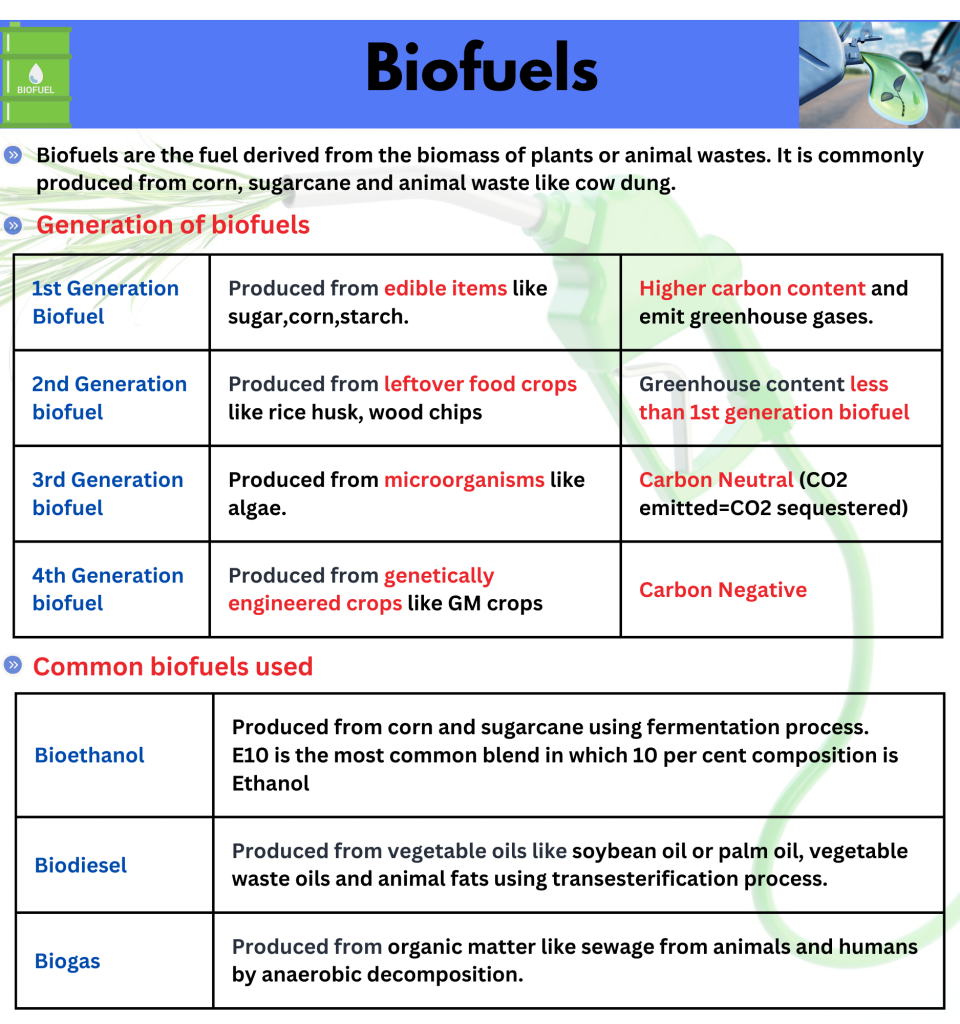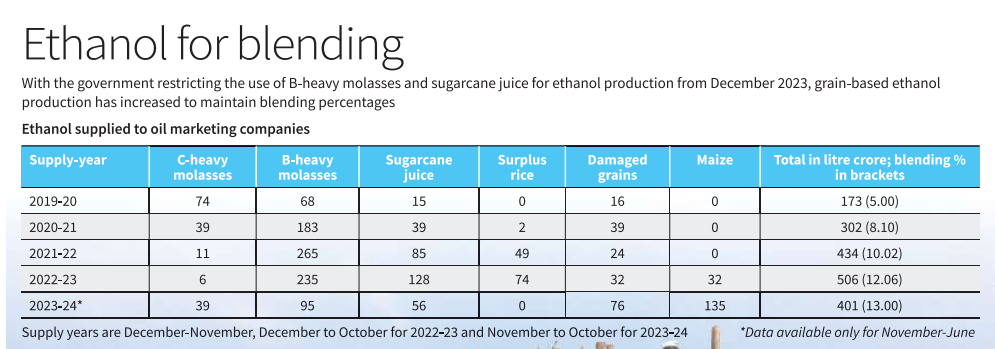India is on course to achieve its E20 Blending target (blending 20% of petrol with ethanol by 2025-26) as part of its Ethanol Blending Programme. The National Policy on Biofuels 2018, had initially set an indicative target of achieving 20% ethanol blending (E20) by the year 2030. However, the target of E20 blending, was advanced to 2025-26 after the NITI Aayog released the expert committee report on ethanol blending titled ‘Roadmap for Ethanol Blending in India 2020-25’.
Going by the milestones on blending percentages crossed so far and the increase in ethanol production capacity, India is on track to achieve its blending target. However, the food versus fuel equation continues to hang over the ethanol economy.

What is the Ethanol Blending Programme? What is the Status of the targets?
Ethanol Blending Programme- The Ethanol Blended Petrol (EBP) program was launched in January 2003. The program seeks to achieve blending of Ethanol with petrol with a view to reduce pollution, conserve foreign exchange and increase value addition in the sugar industry enabling them to clear cane price arrears of farmers.
As per the programme targets, India has to achieve 10% blending rate (E10) by 2021-22 and 20% blending rate (E20) by 2025-26. The average ethanol blending in petrol has risen from 1.6% to 11.8% between 2013-14 and 2022-23.
Sources of Bio Ethanol Production in India
| Sugarcane | Sugarcane gives rise to three main related products, in the order of decreasing sugar content. a. Sugarcane juice and syrup b. B-heavy molasses c. C-heavy molasses (Sugarcane juice and syrup, and B-heavy molasses typically go into making sugar, as they have higher sugar content.) In a bid to up fuel ethanol production, the government had started permitting the diversion of Sugarcane juice and syrup, and B-heavy molasses. However, in December 2023, the government restricted the diversion of Sugarcane juice, syrup, and B-heavy molasses, over fears of falling sugar stocks. |
| Maize | The use of maize for ethanol blending has been increasing to produce more fuel ethanol to compensate for restrictions on using Sugarcane juice, syrup, and B-heavy molasses. |
| Surplus rice & damaged grains | Surplus rice and damaged grains have been permitted by the government for use as a feed in grain-based distilleries. |

What is the significance of Ethanol Blending Programme?
1. Bolsters India’s Energy security- India has a high dependence on imported fuel to meet its energy needs
(In 2021-22, 86 percent of consumed fuel was imported). Such high import dependence, makes India’s energy security vulnerable to global events like the Russia-Ukraine war or oil-cut decisions of OPEC countries. Ethanol blending programme reduces India’s dependence on imported oil, and in turn bolsters the energy security.
2. Import Substitution- Ethanol Blending programme can help in strategically reducing the dependence on imported fossil fuels and conserve foreign exchange reserves. According to NITI Aayog, India’s crude oil import bill will fall annually by about $4 billion by the achievement of E20 target.
3. Reduction of emissions- Use of ethanol-blended petrol decreases emissions such as carbon monoxide (CO), hydrocarbons, and nitrogen oxides. As per NITI Aayog, petrol blended with 20% ethanol would reduce carbon monoxide emissions by 50% in two-wheelers and 30% in four-wheelers.
4. Bolstering Rural Economy and Farmer’s Income- It bolsters the rural economy by promoting the cultivation of various crops (like maize, paddy) through an assured market. Under Ethanol Blending Program, Oil Marketing Companies (OMCs) have paid sugar mills nearly Rs 81,796 crore for ethanol supplies in the last seven years (till 2022), which has helped mills to clear farmers’ dues.
5. Job Creation- As per the Asian Development Bank (ADB), the ethanol blending programme can help in generating about 18 million rural jobs in India.
| Read More- Significance of Biofuels-Explained,Pointwise |
What are the Challenges in achieving 20% Ethanol Blending in India?
1. Rise in import of maize- Government restricted the diversion of Sugarcane juice, syrup, and B-heavy molasses for ethanol production, over fears of falling sugar stocks. This reduction has increased the import of maize from $39 million in 2022-23 to $103 million in FY 2024.
As per NITI Aayog’s estimates, ~ 4.8 million hectares will have to be added to maize cultivation area to meet the 20% target. This additional area is almost half of the current maize cultivation area in India.
2. Financial vulerability of Sugar Mills- The lack of financial stability of the sugar mills to invest in biofuel plants, and their heavy concentration in certain regions, poses a significant challenge to the ethanol Blending Programme.
3. Barriers to Inter-state movement of ethanol- The central government amended the Industries Development and Regulations Act to ensure smooth implementation and transportation of Ethanol across the country. But only 14 states have implemented the amended provisions. As a result, states that produce ethanol more than the requirement for blending cannot transport the Ethanol to other states.
4. Focus of states on ethanol for liquor production- The use of ethanol for fuel blending has failed to attention in states like Tamil Nadu. The Liquor sector remains a highly lucrative market for ethanol distilleries.
5. Modification of existing petrol engines to use E20- The estimated petrol vehicles stock in India is 212.7 million as of March 31, 2023 (176.2 million two-wheelers, 21.8 million three-wheelers, and 14.7 million four-wheelers). The modifications entail significant costs and skilled manpower. This can create considerable disruption in the economy.
What are the concerns with higher ethanol Blending in India?
1. Impact on India’s Food security- The diversion of food crops, such as rice for ethanol production, will hamper India’s food and nutritional security ambitions. For ex- In 2022, close to 1 million metric tonnes of rice fit for human consumption from FCI’s stocks was sold at subsidised prices to produce ethanol.
2. Diversion of Agricultural Land- Excessive blending target can lead to the conversion of agricultural land used for growing food crops, to cultivating biofuel feedstocks like sugarcane, corn, or oilseeds.
3. Impact on Water Availability- Incentives for higher ethanol blending might encourage increased sugarcane and rice cultivation, which are water-guzzling crops. According to TERI, 400 billion litres of water would be needed additionally, which can exacerbate concerns about agricultural sustainability.
4. Impact on Soil Health- The practices of monocropping for biofuel feedstock crops (such as rice, sugarcane) can deplete the nutrients in the soil and make it infertile.
5. Increase in Import of Agricultural Crops- The use of crops like maize for ethanol blending increases the import bill and impacts related agricultural sectors such poultry sector and livestock feed.
What should be the Way Forward?
1. Diversification to higher generation of biofuels- The government should diversify and move to 2G and 3G biofuels, that are more benign in terms of impact on food security.
2. Increase in grain based distilleries- According to the roadmap for achieving ethanol blending targets, prepared by the Niti Aayog, India must invest to increase the capacity of Grain-based distilleries from 258 to 740 crore litres.
3. Interest Subvention programmes- Two interest subvention programmes should be provided for establishment of new distilleries and ramping up of ethanol generation capacity.
4. Streamlining supply chain- The Oil Marketing Companies (OMCs) should sign more long-term contracts with distilleries. The inter-state movement of ethanol should be facilitated to streamline supply-chain.
5. Promotion of maize cultivation in rotation with sugarcane- Maize is not water intensive. However, it degrades soil and cannot be the sole crop either. It should be cultivated in rotation with sugarcane to ensure that soil fertility is not degraded.
6. Increase in fuel ethanol pricing- Increased price support for fuel ethanol can decrease its diversion towards liquor use.
| Read More- The Hindu UPSC Syllabus- GS 3 Environment Conservation |
Discover more from Free UPSC IAS Preparation Syllabus and Materials For Aspirants
Subscribe to get the latest posts sent to your email.





